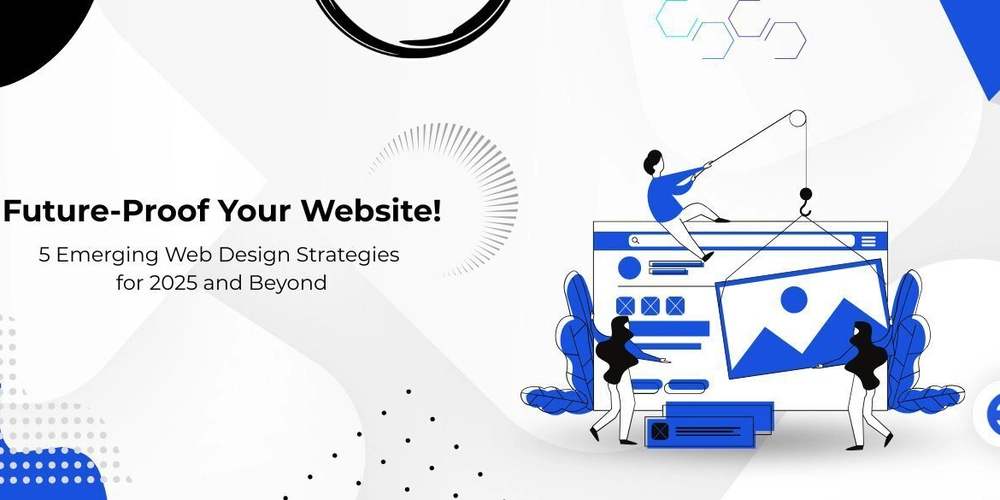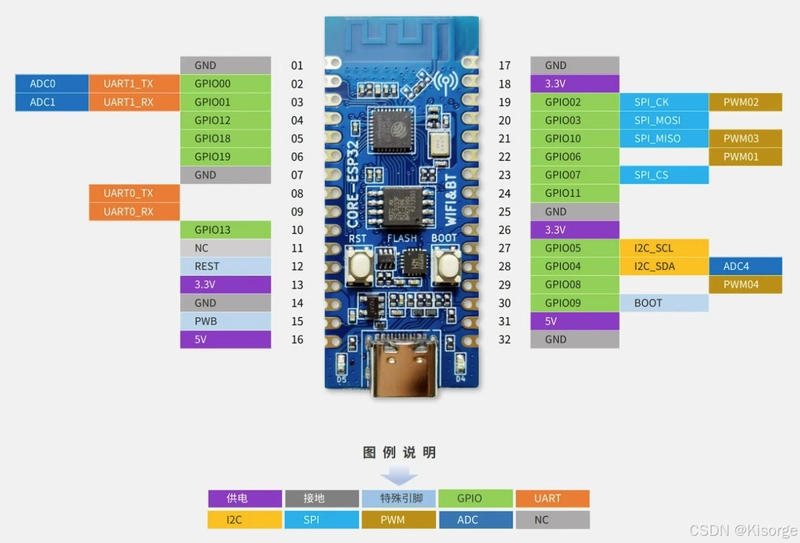Future-Proof Your Website: 5 Smart Web Design Strategies to Stay Ahead in 2025
Your website is your brand’s handshake. It introduces your business. It builds trust. It helps people decide if they want to stick around or walk away. And in 2025, that handshake needs to feel smoother, faster, and smarter than ever before. Web design is no longer about just having a good-looking site. It is about offering an experience that adapts to users’ needs. One that works on every screen, loads quickly, feels natural, and communicates clearly. Let us explore the five most powerful strategies shaping the future of web design. These approaches will help you build a website that is not only modern but ready to grow with your business in the years ahead. Prioritize Website Speed for Better Results If your website is slow, everything else suffers. People leave. Sales drop. Rankings fall. It does not matter how great your content is or how beautiful your design looks. If the site takes too long to load, visitors will not stick around. In 2025, performance is the priority. Web designers and developers are working together to eliminate anything that slows users down. That means using better coding practices, removing unnecessary scripts, and optimizing media files without sacrificing quality. More businesses are using modern technologies like lazy loading, server-side rendering, and lightweight frameworks to speed up interactions. Image formats like WebP help reduce file sizes while keeping visuals sharp. Hosting and caching solutions have also become smarter and more affordable, making fast websites easier to build and maintain. A fast website improves everything. It keeps people engaged, makes your SEO stronger, and helps your business feel more professional. Speed is not a technical detail. It is part of your first impression. Design with Flexibility and Comfort in Mind Great design is not about impressing users. It is about making them feel comfortable. In 2025, that means being flexible. Your website should adapt to different environments, devices, and preferences. Dark mode is a perfect example. Many users now prefer viewing content on darker backgrounds. It feels easier on the eyes, especially at night or in low-light settings. Offering a dark mode option shows that your brand respects user preferences. But comfort goes beyond color themes. Designers are focusing more on spacing, typography, and content layout. Shorter lines of text, larger font sizes, and calming color palettes help users focus and understand your message faster. People should not have to work to read your site. They should feel at ease. That is how you encourage them to stay longer, explore more, and come back again. A visually calm and responsive design makes every user feel at home, no matter when or where they visit your site. Add Small Interactive Elements That Matter You do not need flashy animations to make your website feel modern. What makes a site feel alive in 2025 are small, thoughtful touches known as micro-interactions. These are the tiny reactions users see when they take an action. It could be a soft glow when a button is hovered. A checkmark when a form is completed. A sliding transition when switching between tabs. These moments guide users through your website without needing to explain anything. Micro-interactions help build trust and confidence. They confirm that something is working. They make navigation feel smoother. And they add personality to your brand without overwhelming the user. Designers today are using motion with purpose. These animations are quick, lightweight, and used only when needed. The goal is not to decorate the site but to enhance the experience. A good website speaks the user’s language. Micro-interactions are one of the ways it speaks clearly and kindly. Use AI-Powered Personalization to Improve Engagement Everyone wants a website that feels relevant. Thanks to AI and smarter data tools, that is now possible for almost every business. Personalization in web design means adjusting the experience based on who is visiting. It can be as simple as recommending products based on browsing history. Or as advanced as showing different homepage messages based on location, device, or time of day. In 2025, personalization is becoming more natural. Websites are using AI tools to analyze user behavior and adjust in real time. This makes your site feel more like a helpful guide than a static brochure. When people feel like your content fits their needs, they are more likely to engage. More likely to trust your brand. And more likely to convert. But it is important to use personalization with care. Avoid making things feel too automated. Keep control in the hands of the user. Always give people the option to opt in or out of customized features. When used wisely, AI creates websites that are not just smarter but more human too. Make Accessibility a Built-In Feature, Not an Afterthought A truly future-proof website works for everyone. That means

Your website is your brand’s handshake. It introduces your business. It builds trust. It helps people decide if they want to stick around or walk away.
And in 2025, that handshake needs to feel smoother, faster, and smarter than ever before.
Web design is no longer about just having a good-looking site. It is about offering an experience that adapts to users’ needs. One that works on every screen, loads quickly, feels natural, and communicates clearly.
Let us explore the five most powerful strategies shaping the future of web design. These approaches will help you build a website that is not only modern but ready to grow with your business in the years ahead.
Prioritize Website Speed for Better Results
If your website is slow, everything else suffers. People leave. Sales drop. Rankings fall. It does not matter how great your content is or how beautiful your design looks. If the site takes too long to load, visitors will not stick around.
In 2025, performance is the priority. Web designers and developers are working together to eliminate anything that slows users down. That means using better coding practices, removing unnecessary scripts, and optimizing media files without sacrificing quality.
More businesses are using modern technologies like lazy loading, server-side rendering, and lightweight frameworks to speed up interactions. Image formats like WebP help reduce file sizes while keeping visuals sharp. Hosting and caching solutions have also become smarter and more affordable, making fast websites easier to build and maintain.
A fast website improves everything. It keeps people engaged, makes your SEO stronger, and helps your business feel more professional.
Speed is not a technical detail. It is part of your first impression.
Design with Flexibility and Comfort in Mind
Great design is not about impressing users. It is about making them feel comfortable. In 2025, that means being flexible. Your website should adapt to different environments, devices, and preferences.
Dark mode is a perfect example. Many users now prefer viewing content on darker backgrounds. It feels easier on the eyes, especially at night or in low-light settings. Offering a dark mode option shows that your brand respects user preferences.
But comfort goes beyond color themes. Designers are focusing more on spacing, typography, and content layout. Shorter lines of text, larger font sizes, and calming color palettes help users focus and understand your message faster.
People should not have to work to read your site. They should feel at ease. That is how you encourage them to stay longer, explore more, and come back again.
A visually calm and responsive design makes every user feel at home, no matter when or where they visit your site.
Add Small Interactive Elements That Matter
You do not need flashy animations to make your website feel modern. What makes a site feel alive in 2025 are small, thoughtful touches known as micro-interactions.
These are the tiny reactions users see when they take an action. It could be a soft glow when a button is hovered. A checkmark when a form is completed. A sliding transition when switching between tabs. These moments guide users through your website without needing to explain anything.
Micro-interactions help build trust and confidence. They confirm that something is working. They make navigation feel smoother. And they add personality to your brand without overwhelming the user.
Designers today are using motion with purpose. These animations are quick, lightweight, and used only when needed. The goal is not to decorate the site but to enhance the experience.
A good website speaks the user’s language. Micro-interactions are one of the ways it speaks clearly and kindly.
Use AI-Powered Personalization to Improve Engagement
Everyone wants a website that feels relevant. Thanks to AI and smarter data tools, that is now possible for almost every business.
Personalization in web design means adjusting the experience based on who is visiting. It can be as simple as recommending products based on browsing history. Or as advanced as showing different homepage messages based on location, device, or time of day.
In 2025, personalization is becoming more natural. Websites are using AI tools to analyze user behavior and adjust in real time. This makes your site feel more like a helpful guide than a static brochure.
When people feel like your content fits their needs, they are more likely to engage. More likely to trust your brand. And more likely to convert.
But it is important to use personalization with care. Avoid making things feel too automated. Keep control in the hands of the user. Always give people the option to opt in or out of customized features.
When used wisely, AI creates websites that are not just smarter but more human too.
Make Accessibility a Built-In Feature, Not an Afterthought
A truly future-proof website works for everyone. That means it must be accessible. Not just visually appealing to some users, but fully usable by all people regardless of their abilities.
Accessibility includes a wide range of design choices. It involves using proper color contrast so text is readable. Making sure all images have meaningful alt text. Creating clear heading structures for easy navigation. And ensuring that all features work with screen readers and keyboard navigation.
In 2025, accessible websites are not just ethically correct. They also perform better. Many of the practices that improve accessibility also improve search engine optimization and user experience in general.
Designing for accessibility helps you reach a larger audience, including users with visual, hearing, cognitive, or motor challenges. It shows that your business cares about inclusion and quality.
Building a site that everyone can use is not difficult. It just takes awareness and intention. And it is one of the smartest investments you can make in your digital presence.
Final Thoughts: What It Means to Design for the Future
Web design in 2025 is not about doing more. It is about doing better.
It is about simplifying the experience. Making your site faster, clearer, and easier to use. Designing for comfort, interaction, and inclusion. And letting smart technology serve the user, not distract them.
By applying these five strategies, you are not just following trends. You are building something sustainable. Something that grows with your audience. Something that stays relevant in a changing world.
Your website should be more than a digital space. It should be a meaningful experience.
Start with speed. Design with comfort. Interact with care. Personalize with purpose. And open the door to everyone.
That is how you future-proof your website.
Want to dive deeper into what’s changing in web design this year?
Check out our full feature: Top 5 Latest Web Design Trends in 2025 and Beyond




























![[Webinar] AI Is Already Inside Your SaaS Stack — Learn How to Prevent the Next Silent Breach](https://blogger.googleusercontent.com/img/b/R29vZ2xl/AVvXsEiOWn65wd33dg2uO99NrtKbpYLfcepwOLidQDMls0HXKlA91k6HURluRA4WXgJRAZldEe1VReMQZyyYt1PgnoAn5JPpILsWlXIzmrBSs_TBoyPwO7hZrWouBg2-O3mdeoeSGY-l9_bsZB7vbpKjTSvG93zNytjxgTaMPqo9iq9Z5pGa05CJOs9uXpwHFT4/s1600/ai-cyber.jpg?#)













































































































































![[The AI Show Episode 144]: ChatGPT’s New Memory, Shopify CEO’s Leaked “AI First” Memo, Google Cloud Next Releases, o3 and o4-mini Coming Soon & Llama 4’s Rocky Launch](https://www.marketingaiinstitute.com/hubfs/ep%20144%20cover.png)





































































































































































































![Rogue Company Elite tier list of best characters [April 2025]](https://media.pocketgamer.com/artwork/na-33136-1657102075/rogue-company-ios-android-tier-cover.jpg?#)







































































_Andreas_Prott_Alamy.jpg?width=1280&auto=webp&quality=80&disable=upscale#)































































































![What’s new in Android’s April 2025 Google System Updates [U: 4/18]](https://i0.wp.com/9to5google.com/wp-content/uploads/sites/4/2025/01/google-play-services-3.jpg?resize=1200%2C628&quality=82&strip=all&ssl=1)








![Apple Watch Series 10 Back On Sale for $299! [Lowest Price Ever]](https://www.iclarified.com/images/news/96657/96657/96657-640.jpg)
![EU Postpones Apple App Store Fines Amid Tariff Negotiations [Report]](https://www.iclarified.com/images/news/97068/97068/97068-640.jpg)
![Apple Slips to Fifth in China's Smartphone Market with 9% Decline [Report]](https://www.iclarified.com/images/news/97065/97065/97065-640.jpg)
































































































































